Strength for Beginners
A 2-3 day/wk, full body weight training program designed to introduce barbell exercises and basic compound exercises to novice lifters while improving strength and hypertrophy.
Program Overview
The Beginner program is an introductory weight training routine designed to familiarize new lifters with a few standard movement patterns and the barbell. The Beginner is ideally meant to serve as a temporary (2-6+ month) learning period to help new lifters transition to more intense and higher frequency routines. If you’re interested in incorporating a more serious weight training program into your routine but don’t know where or how to begin, this is the place to start. This program is also great for those who have been out of the gym for an extended period of time.
The Beginner program emphasizes strength development. It consists of two alternating days that are performed 2-3 times per week. Each day contains only four compound exercises. I recommend new lifters start with the twice per week version and maintain that training frequency until they stop seeing consistent progress. Increase your weekly training frequency to 3X when 2X stops being effective.
Simplified versions of these two days are listed below.
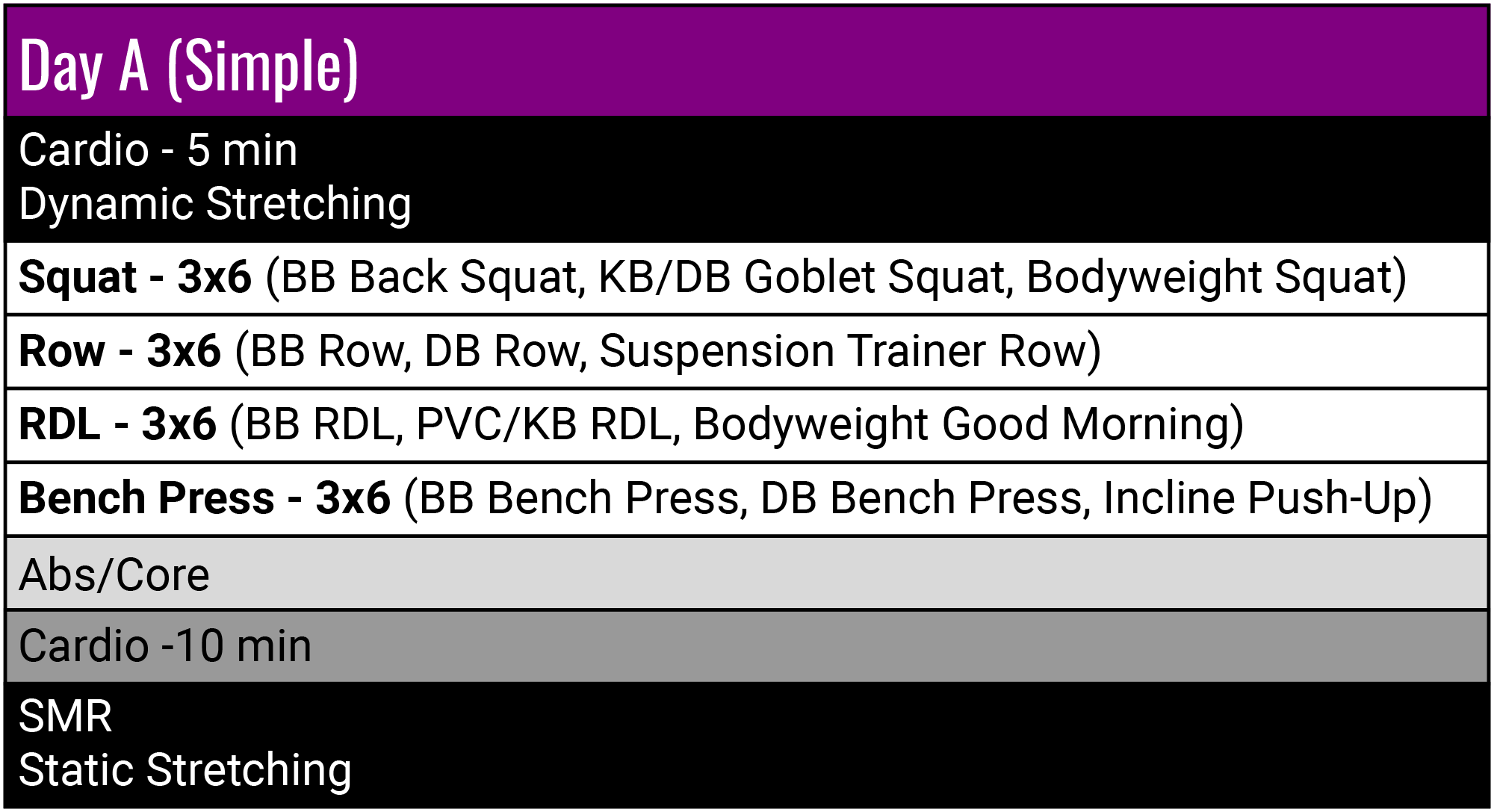
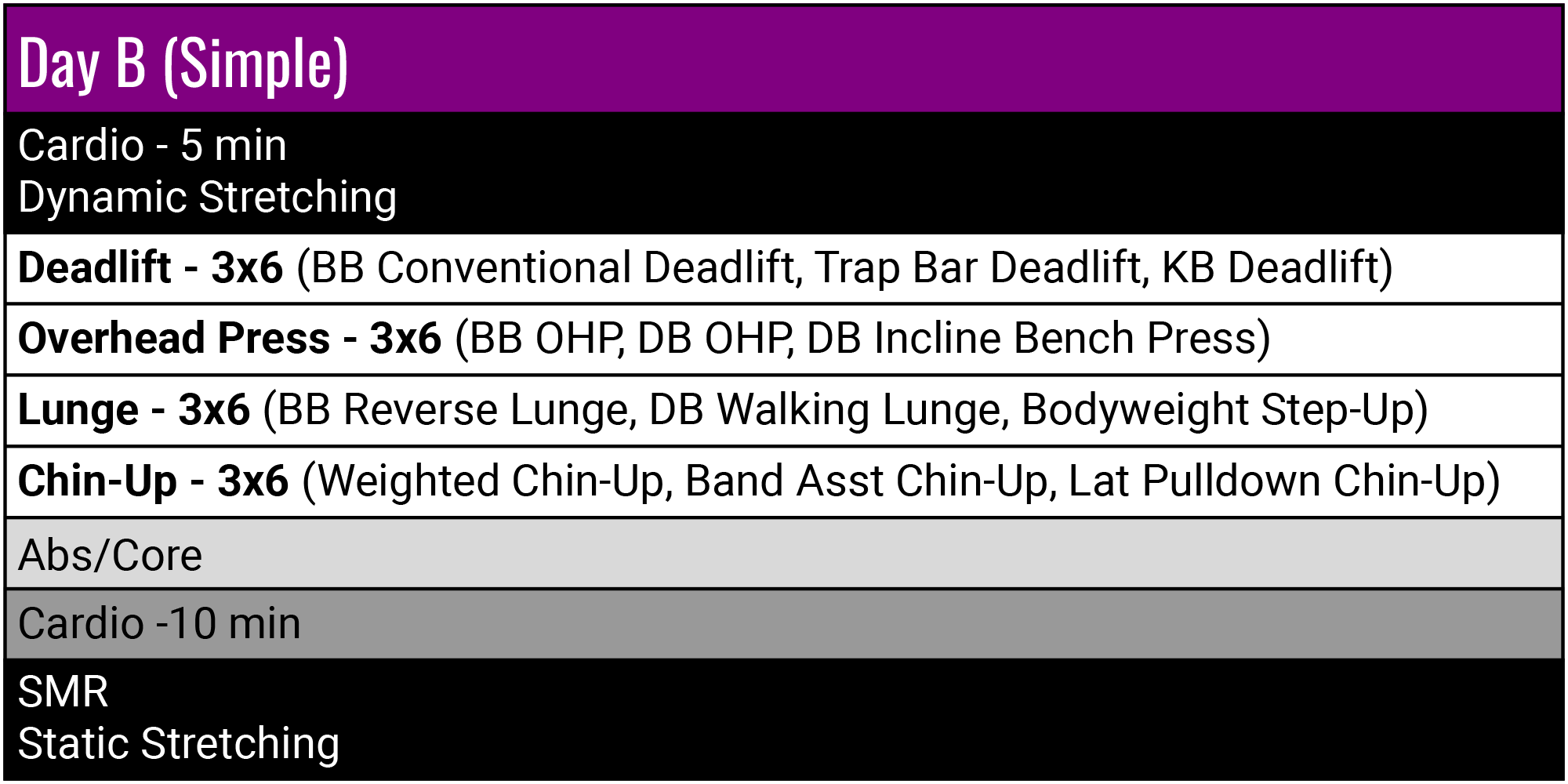
All working sets should be performed with a challenging weight (RPE 7+), but avoid failure. Leave 1-2 reps in reserve. Aim to add a moderate amount of weight (5-10 lbs) to your lifts weekly or increase reps (up to 8). When 3×8 is consistently repeatable, drop the reps back to 6 and add a little weight. Give yourself 48-72 hours of rest between sessions. The simplified version shows both the standard working set exercises and their modifications, from most to least difficult.
How long should you spend in the learning phase? There’s not an exact duration for the initial A/B split, but all new lifters should spend at least 2-3 months on this program. Closely monitor your weekly progress to determine when you’ve reached an intermediate experience level which is defined by a strength plateau. When you stop improving from the same basic workouts, it’s time to move on. Some may reach this point after 2-3 months while others might continue progressing up to a year. Listen to your body, do what’s best for you, move on when you’re ready, but do not rush it. The more strength you build at the beginning, the heavier your high volume work will be later.
If you plateau on the Beginner but don’t want to change the routine significantly, modify the rep scheme by adding some simple progressive overloading. Instead of 3×6 for all lifts, run a four week cycle with 12/10/8/6 weekly rep counts. (3×12 for all lifts week one, 3×10 for all lifts week two, etc.) Similar to the standard program, keep repeating this cycle until you stop seeing progress.
Download the full program using the link above to view all exercise details, terms/abbreviations, and supplemental fat loss cardio.
Example Weeks
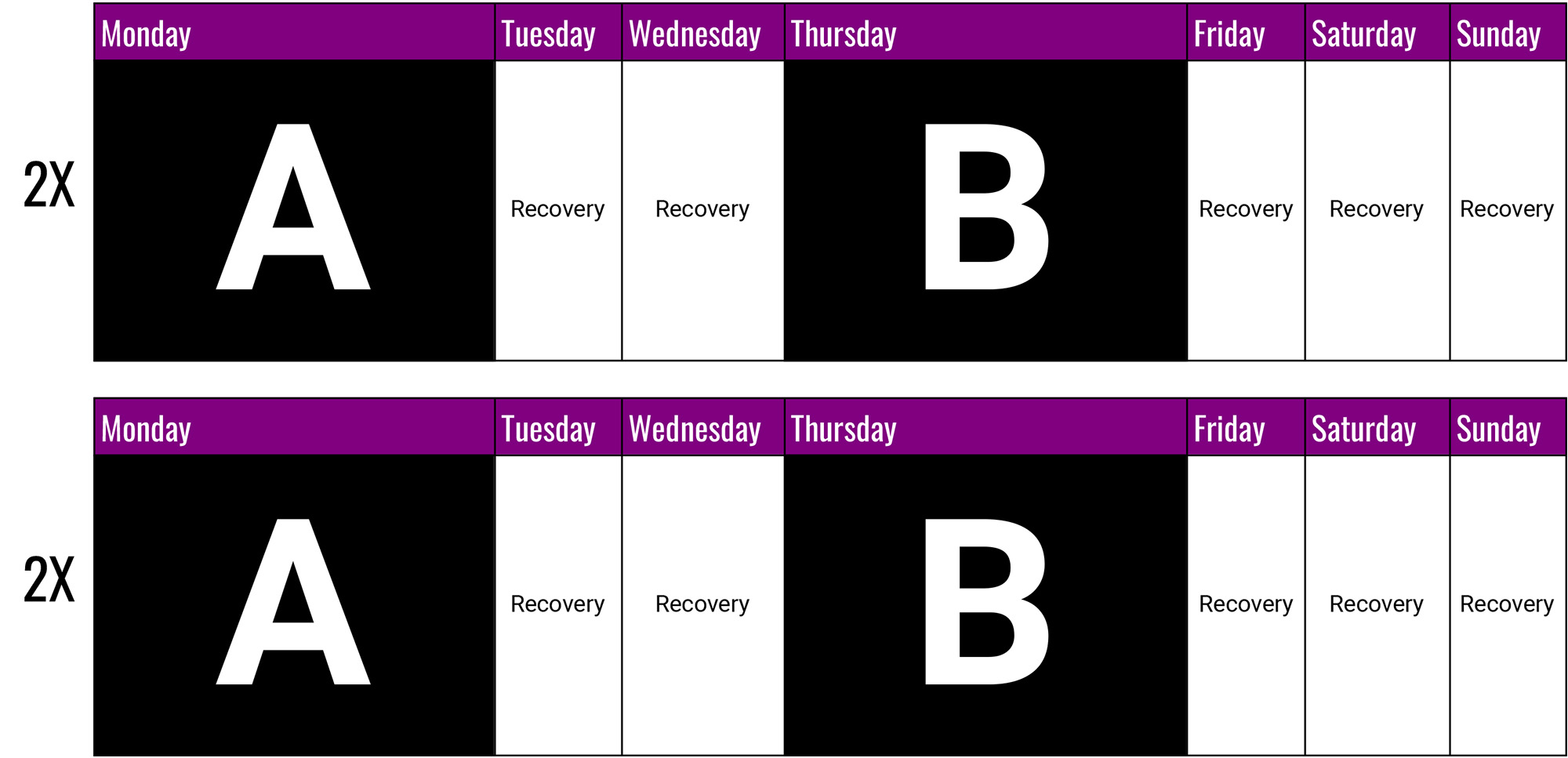
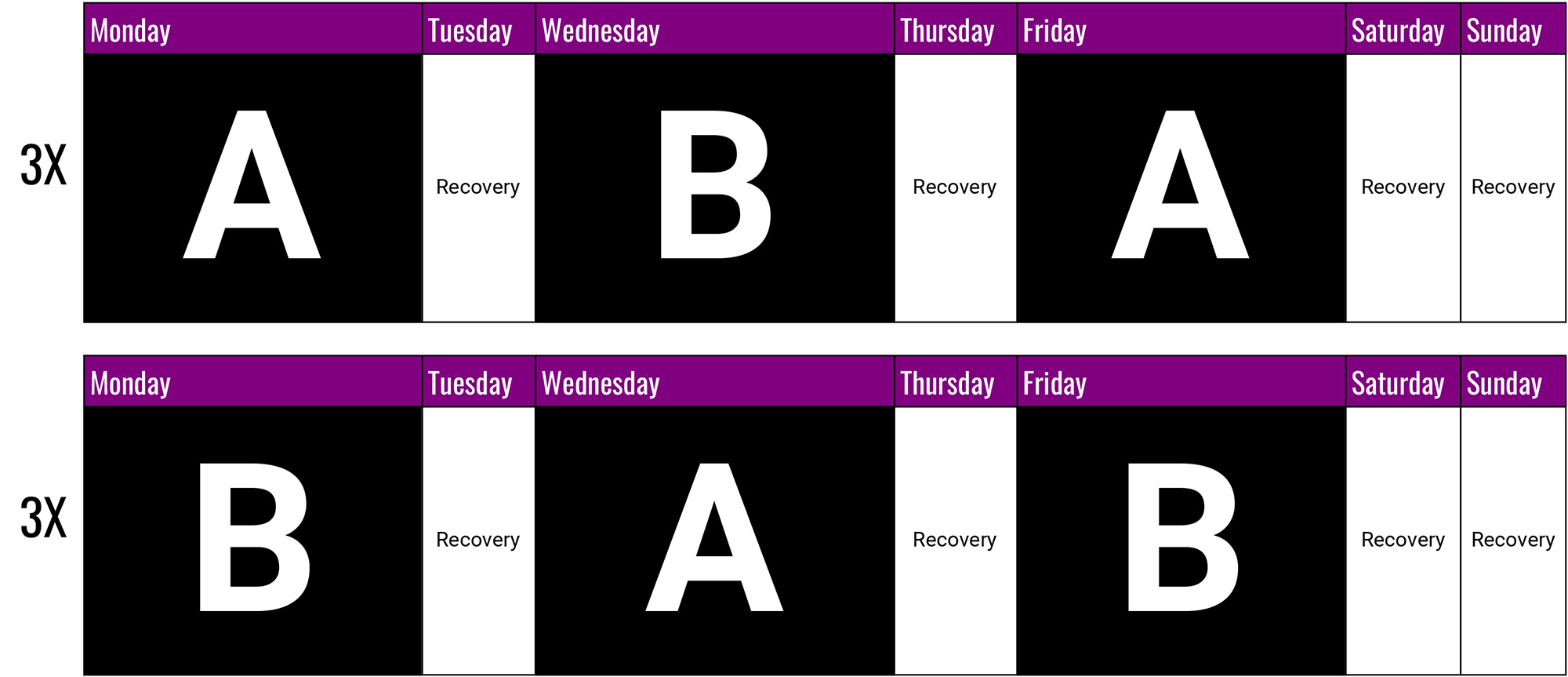
Why is Strength Important?
Learning to Lift
The following is an excerpt from chapter one of Fitness & Nutrition Programming for Beginners. This introduction to resistance training should help new lifters understand why strength training is essential at the beginning and how to implement it most effectively. Check out the full book for more information.
“Before we dive into resistance training fundamentals, it’s important to first cover some guidelines for new lifters to ensure maximum beginner gains are made before moving on to advanced programs.
If you’re untrained or have little to no recent exercise experience, you’re basically superhuman and most standard resistance training rules won’t apply to you. As a beginner, you’ll make massive weekly leaps in strength, muscular size, and cardiovascular endurance. Good program design or bad, you’ll continue to improve. But the bad habits that initially worked well will eventually become ineffective and impede future growth. To set yourself up for long-term success, take advantage of this accelerated progress phase by properly learning the basics and implementing smart habits.
How should beginners start?
First, set a goal for yourself and have a clearly defined reason to train. Interested in bodybuilding? Great. Want to improve strength so you’re better on the Pilates reformer? Fantastic. There’s no wrong answer here. Be sure to know what you’re working towards. All programs need direction.
Next, focus on building a solid foundation of strength. Strong muscles increase our growth potential and improve the quality of non-lifting activities like running, climbing, dancing, etc. All aspects of your life will improve if you can move with less effort.
Strength is easy to improve at the beginning because initial weakness isn’t caused entirely by a lack of muscle mass. Instead, a novice’s inability to lift heavier loads is typically caused by poor neuromuscular coordination and a lack of motor control. This means beginners have enough muscle mass to lift relatively heavy weight, but their brains aren’t good at communicating with their muscles to produce consistent, controlled force. By treating strength as a skill and practicing it often, new lifters can learn to be strong and simultaneously build a significant amount of new muscle mass with a modest level of effort. That’s a training win-win.
The learning phase for strength is intentionally very simple. Beginners should –
- Focus on non-periodized, full body workouts that are performed 2-3 times per week.
- Each session should contain 3-4 working sets per exercise.
- Each set should contain 5-8 reps with a challenging weight.
- Avoid failure and leave 1-2 reps in reserve per set most of the time.
- Aim to add a moderate amount of weight (5-10 lbs) to your lifts weekly.
These suggestions mean you can basically do the same workouts every week and only need to focus on adding small amounts of weight when appropriate. Reducing initial program complexity helps beginners develop proper form, spatial awareness, and an understanding of their physical capabilities.
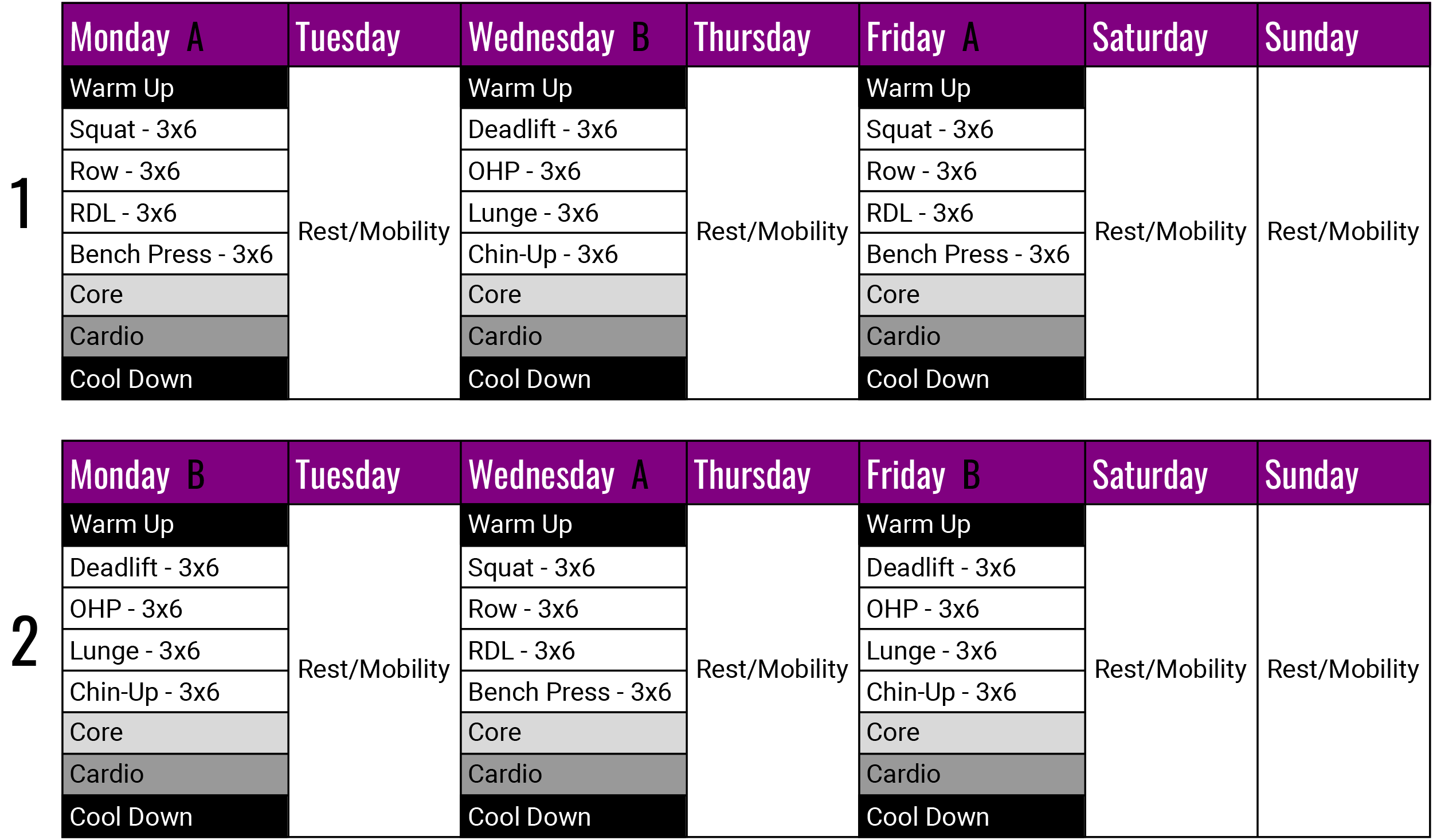
“The Fitstra Beginner program follows these suggestions and the first two weeks are listed above. This sample section contains two different weeks where workouts A and B alternate each day. There are only eight different compound exercises in the A/B split, making it an easy routine to learn. Stick to this strength protocol or one like it for at least the first two months and limit high-rep sets that target hypertrophy. There’s a good chance you won’t significantly increase muscle size during this eight week period anyway. The increased volume from high-rep sets may cause muscle damage (inflammation often mistaken for hypertrophy) and unnecessary fatigue, impeding growth.
Why is this strength phase so important?
The more strength you build at the beginning, the heavier your subsequent high-volume work can be. This will help you build more muscle. Think of the strength phase as a slingshot that takes an initial investment of time and energy to build but allows you to rapidly progress when released. Become as strong as possible before you change program variables like rep ranges or exercise frequency.
Finally, early equipment and exercise selection should mirror the program you’re going to follow. If you decide to work with the Fitstra Beginner program or one similar to it, you will use a barbell for many of the exercises. Start with the bar from day one or introduce it as soon as you build enough strength, coordination, and confidence. You’ll feel more comfortable with this piece of equipment each time you use it. In any fitness setting, learning to use the tool is just as important as learning to move the weight. Some studies indicate that external cuing is more beneficial than an internal focus for beginners. This means novice lifters should visualize the bar path and prioritize form rather than trying to activate a muscle. As movements become more familiar, focus on contracting the muscles being worked in each exercise.
Because there’s not an exact duration for the beginner phase, closely monitor your weekly progress to determine when you’ve reached an intermediate experience level. This point is typically defined by a strength plateau. When you’re comfortable with the pieces of exercise equipment in your program and stop improving from the same basic workouts, it’s time to move on to bigger and better things. Some may reach this point after a few months, while others might continue progressing over a year.
Listen to your body, do what’s best for you, move on when you’re ready, but don’t rush things. An extra month spent solidifying your foundation with the possibility of minimal returns is much better than moving on too soon. Don’t leave easy gains on the table.
You now know how to start your resistance training journey. Great. But how do you progress from beginner to intermediate? What is a periodized program? How many reps and sets should you do per workout? To answer these questions, let’s start with the basics.”
For more resistance training information, read Fitness & Nutrition Programming for Beginners.
Form FAQ
Exercise Form Video Library
The following video examples are provided to supplement your learning, but the links shared should not be your only source of instruction. No single educator can teach you everything. Seek out other respected content creators and learn from as many experts as you can.